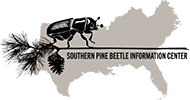Abstract
The devastating attack of Dendroctonus frontalis Zimm. on pine trees depends on successful host selection, mass aggregation, and colonization, often progressing rapidly from tree to tree within a forest. Females beginning the attack release a pheromone, and the penetration of the bark by these beetles liberates host volatiles which complete the potent population attractant. The principal pheromone has been identified as l,5-dimc thyl-6,8-dioxabicyclo [B.2.1] octane (“frontalin”), which is concentrated in the hindguts of emergent adults. Other compounds identified from D. frontalis hindguts are trans-verbenol in females and vorbenone in males. We now report the identification of the host terpene responsible for boosting the attraction of frontalin, and results which explain the roles of trans-verbenol and verbenone in the aggregation mechanism.
To read the full article please visit the link below:
RENWICK, JAA, and JP VITE. 1969. “BARK BEETLE ATTRACTANTS -MECHANISM OF COLONIZATION BY DENDROCTONUS FRONTALIS.” Nature224 (5225): 1222-. https://doi.org/10.1038/2241222a0.
